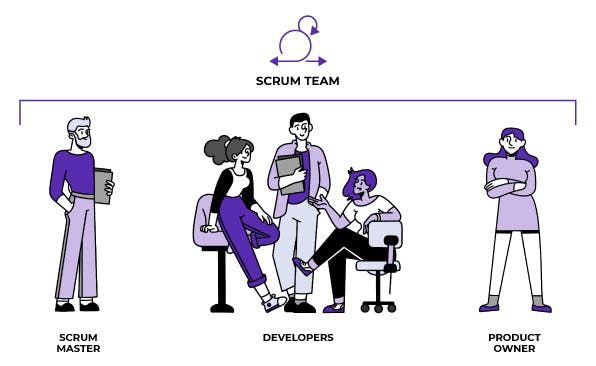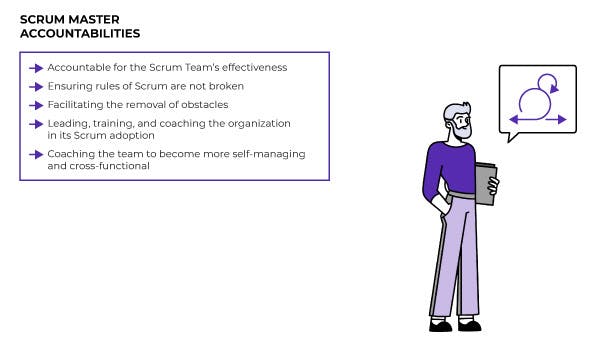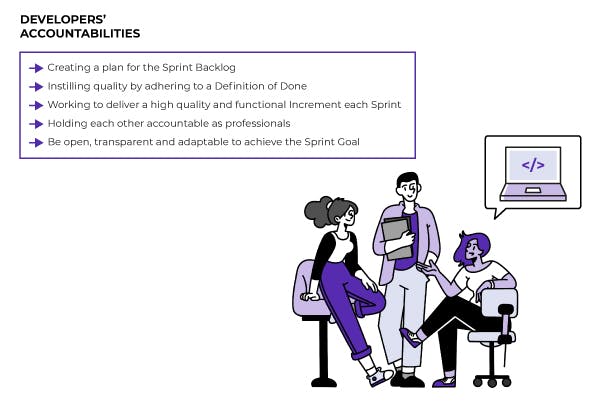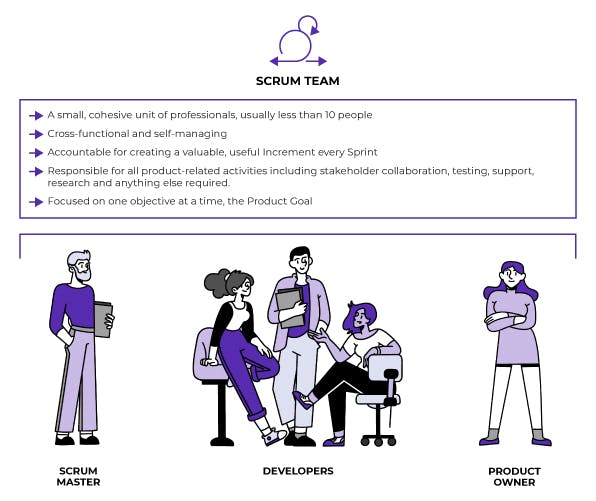Learn Agile & Scrum
08-Identify the Members of the Scrum Team
Identify the Members of the Scrum Team
Loading video: EN_4544621_CRS_learn-about-agile-project-management-and-the-product-owner-role_0-0_2-2_TLK.mp4...
Scrum Roles
Scrum defines three main roles for its team members, which are referred to as accountabilities.
These three levels of accountability, as a group, comprise the Scrum Team.


Three roles of the Scrum Team
The Product Owner
The Product Owner is responsible for maximizing the value that the Scrum Team delivers. They do this in several ways. While they can delegate responsibility, they remain accountable. One main way of accomplishing this is for the Product Owner (PO) to maintain a Product Backlog of future work items and order the backlog to see the best order to work the items. Many factors go into ordering a backlog, such as size, complexity, risk, value, etc. A Product Owner can use any tool or criteria they’d like.
We've talked about the backlog in a previous chapter, but as a reminder, the Scrum Guide defines a Product Backlog as:
An emergent, ordered list of what is needed to improve the product. It is the single source of work undertaken by the Scrum Team.
The Product Owner must ensure that the entire organization can see the following items to be worked on and the Scrum Team understands them. They must also ensure that these items are ready to be worked on. If elements such as UX designs, copy, or translations are required, the Product Owner ensures they are ready. In particular, they need to consider any major design or logical decisions. If the tech team asks any questions when planning the feature, the Product Owner must provide answers.
Therefore, the Product Owner will decide what is worked on in the future. They maintain relationships with major stakeholders to know the organization's highest priority.


Responsibilities of the Product Owner
If you are wondering about the difference between the terms Product Manager and Product Owner, visit my other course in this path: . In brief, the Product Owner is a Scrum-specific role. The Product Manager is called a Product Owner in Scrum.
The Scrum Master
The Scrum Master is the person who contributes the most to assisting the team and organization in understanding and respecting the rules and behaviors of Scrum.
It can be helpful to think of the Scrum Master's contribution in three ways:
1. Service to the Scrum Team
The Scrum Master provides support by being the principal contact when issues arise. For example, if a team member is blocked from doing their work, they should inform the Scrum Master right away. The Scrum Master will do their best to help them remove the impediment for themselves or work on removing it for them if that is the best course of action.
The Scrum Master ensures that the team understands Scrum and adheres to its rules. They also promote a culture of self-organization, ownership, and effective communication. In addition, they will often facilitate meetings or events and help team members who are dealing with people in the organization who may not understand Scrum.
Think of the Scrum Team as being the tech team (all developers, testers, designers, database engineers, development operations, etc.) that works on the product. Anyone who contributes work to the Increment is called a Developer and is on the Scrum Team. Scrum recognizes no sub-roles.
2. Service to the Organization
The Scrum Master plays a leading role in helping the organization understand Scrum principles. For example, if teams are introducing Scrum, the Scrum Master will play a major coaching role, ensuring that key stakeholders understand the benefits. In particular, if any managers try to "break" Scrum by requesting that the team engage in outside activities, the Scrum Master will step in and help facilitate the interactions to ensure that Scrum is upheld.
3. Service to the Product Owner
The Scrum Master will assist the Product Owner in their duties as needed or as requested. These could include managing the Product Backlog, defining a Product Goal, or clearly expressing Product Backlog items, just to name a few. At times a Product Owner may need to delegate, and that person could be the Scrum Master, although they are just one possibility. Scrum Masters may also help Product Owners work with stakeholders, customers, or other organization members.


Responsibilities of the SCRUM Master
When there are many Scrum Teams within an organization, the Scrum Master will talk to other Scrum Masters of other Scrum Teams to make sure their work overlaps effectively. If there were five Scrum Teams in an organization, each with their own Scrum Master, then those five Scrum Masters would meet to see if teams are working on anything overlapping that requires inter-team communication and planning.
The Developers
The programmers, software developers, designers, testers, and others who work on the product are known as Developers in Scrum. The Developers, the Scrum Master, and Product Owner, are known collectively as the Scrum Team. The Developers do the actual work of building, testing, and releasing the software/product.


Developers’ Accountabilities
The Scrum Team has the following characteristics:


Scrum Team summary
Let’s Recap!
Now that you know more about the team roles, let's discover the different events of the Scrum framework!
Want to print your doc?
This is not the way.
This is not the way.

Try clicking the ⋯ next to your doc name or using a keyboard shortcut (
CtrlP
) instead.